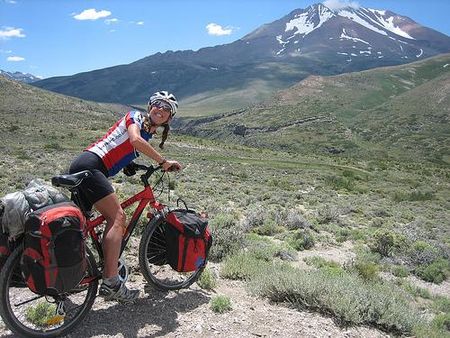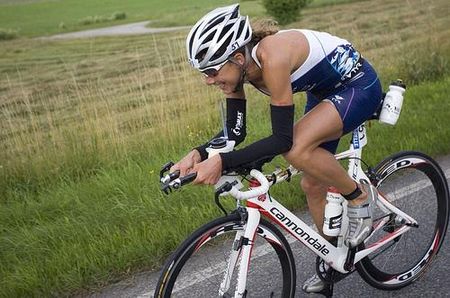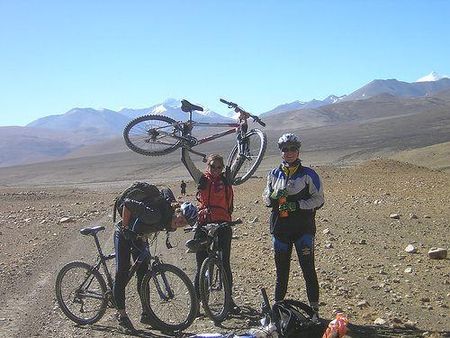
Most people know me as the woman who has won three consecutive World Ironman Championships, and maybe for breaking the world record twice. But there was a time, pre-triathlon, when I lived and worked in the Himalayan paradise that is Nepal, which helped shape me into the person and athlete I am today.
With professional sport being the axis on which my life now spins, I often think back to my life in Nepal. Even then I was sport junkie who wanted to keep fit, race the boys, and get that endorphin rush, but there was so much more. Biking gave me the chance to spend time with the local Nepalis, learn about their culture, visit remote places and see sights that took my gasping bike-breath away–never once thinking about a log book, interval, heart rate, or hill repeat. It was sport at its rawest and most fun.����
We started at the crack of dawn. The mornings were beautiful, with the sun rising over the Himalayas and its foothills. It was also the time when you see cows meandering like drunks down the streets, the butchers butchering live goats, the Hindu devotees giving offerings to their pantheon of gods, and the heart wrenching sight of young street children delving into the piles of rubbish, seeking scraps of anything to eat or sell, or sitting in doorways sucking fumes out of paper bags in a desperate bid to numb themselves from the pain of poverty. Such sights make you realize just how fortunate you are.

The biking group had a few meeting points around the city, depending on the chosen route. All of them centred on a chiiya–or tea–stall, where cups of this sweet, spicy, milky beverage were consumed by the gallon at the side of the road, and always accompanied by a deep-fried donut, complete with parasites and other unsanitary freeloaders. Although two cups of chiiya was tantamount to dental suicide, it was also enough to power us through two hours of biking and beyond.
The cycle routes led us out of the city, through the chaotic traffic where overloaded motorbikes, rickety buses, and cars were interspersed with rickshaws, pedestrians, monkeys, chickens, and the obligatory pothole. Traffic lights, when they worked, were not obeyed, and the horn was deployed at every opportunity.
This daily death dash out of Kathmandu lasted all of ten minutes, and then peace prevailed. We cycled on single and double track trails around the valley, through lush green, terraced paddy fields, where the buffalo pull plows and the kurta (traditional Nepali dress) clad women hunched over their crops. We climbed up the valley sides, through small villages with their ochre mud houses, passed elaborately carved Hindu temples and dome-shaped Buddhist stupas, where devotees performed their daily pujas–spinning prayer wheels or placing bright crimson tikkas on concrete deities. We passed huge garlands of shining red chillis drying in the sun, endless fields of bright yellow rapeseed, and gorgeous hibiscus flowers–all against the backdrop of the Himalayan mountains, their snow-clad, 8,000-meter peaks rising like ice cream cones above the clouds.��

There were primarily two types of rides, the morning ride and the weekend ride. Both were tough, hilly, and awe inspiring. The difference was the length. The weekday morning ride would last about two hours, after which I had to go to that thing we call work. The weekend rides were much longer. We didn’t know how far we would go, or really how long it would take. We just rode, stopping off at small villages to refuel. Nutrition and hydration were spare–chiiya, fizzy drinks, chick peas in curry sauce, coconut biscuits/cardboard (a snip at four cents a packet), or the deep-fried, parasitic, no-jam donut. No gels, no sports beverages, and no expensive energy bars. Mechanical problems regularly arose and were resolved with varying degrees of competence. Flat tires were easy. As long as we had duct tape. Broken chains were more problematic. But the Nepalis are can-do people, and it is possible to mend anything with a bit of ingenuity.
The long weekend rides comprised overnight stops wherever we ended up. We often stayed in a local’s house, or occasionally a Buddhist monastery–much to the amusement of the saffron-robed monks. Dinner was always the same–dhal bhat. The meal of rice, lentil soup, and a curry (of varying degrees of deliciousness) that Nepalis consume twice a day, every day. Always eaten with our hands (the right one, as the left one is traditionally used for other, less sanitary activities). And the next day would take us back to Kathmandu, using the most indirect route possible. We would arrive home, exhausted, sweaty, hungry but on a high that made the Himalayas seem like molehills. I didn’t have to download any data or put a tick in a log book to tell me just how much each ride enriched and inspired me.
–Chrissie Wellington
Chrissie Wellington stunned the world of triathlon by for women in Roth, Germany, in July 2010. The time she beat was her own, clocking in at 8:19:13, 12 minutes and 46 seconds faster than her previous record. The Brit also has the distinction of winning the most esteemed triathlete victory three years in a row: Ironman Kona in 2007, 2008, and 2009. She'll be back this year to go for number four. Be sure to check the ���ϳԹ��� Blog for more posts by Wellington as she heads toward the big day at Kona. ��